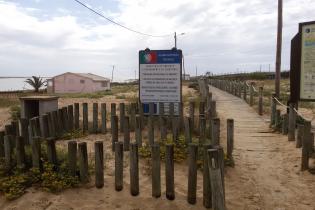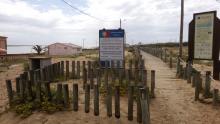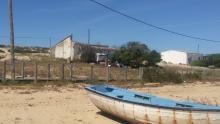
A construction of an elevated wooden pathway alongshore and cross-shore of about 1500 m, and the construction of a dune fences were implemented in the coastal town of Praia de Faro (Portugal). The fences helped to trap sand in the dune areas leading to a growth of the dune system. The wooden path played also an important role in the dune recovery.
The Ria Formosa coastal lagoon is a RISC-KIT Case Study site and is located on the southern coast of Portugal. The coastal town of Praia de Faro is located partly on a natural dune area separating a lagoon from the open sea. Due to tourism and housing activities the dunes were in bad conditions, so two main actions were undertaken in 2000/2001: construction of an elevated wooden pathway alongshore and cross-shore of about 1500 m, and the construction of a dune fences. A row of fences was placed along the ocean side for about 1 km and additionally fences were built as a a reticulate for 670m (continuous rectangles or about 7x5.5 m). The fences helped to trap sand in the dune areas leading to a growth of the dune system. Over the past 15 years the dunes grew around 10 meters in width and about 1.3 meters in height, leading to an almost natural ecological state. The wooden path played an important role in the dune recovery, because it led to reduction of wild paths through the dunes. Wild path through the dunes caused a destabilization of the dune system. With the pathway, tourists, fishers, and inhabitants use the path to reach the shore or other areas. The fences were also an additional obstacle which minimized the usage of wild paths through the dunes.
Over the time span of 15 years, the measure showed an improvement of the dune systems where the pathway and the fences were built. Before the measure was implemented there were overwashes in the area, but these did not occur in the last years. With no extreme storm events or human intervention, the dunes should stay rehabilitated for the next decades.
Political & social feasibility:
The constructed wooden path was well received by inhabitants and tourists. For recreational purposes the measure had a positive impact, because it is now easier and faster to get to different spots ate the oceanic shore and the back barrier beach, where the area is used for bathing, surfing, or kite-surfing. To get to these areas, the pathway is used.
Cost of implementation & maintenance
The initial costs of the measures were around 1250000€. 4/5 of the costs were paid with EU funds, 1/5 was paid with national funding. There is no money assigned for maintenance costs. If maintenance is needed, is overtaken by local fisherman or house owner (basically by replacing broken parts of the wooden path or the fence). For a more detailed cost effectiveness analysis see here.
Ecological feasibility
With the measure the ecological status of the dune system is near to natural values with natural (autochthon) species dominating the ecosystem. Allowing the natural evolution of the dune ecosystem, this approach can be classified as ecological feasible. Problems could arise if the new system attract a lot more tourists, that could put additional pressure on the ecosystem (e.g. too many bird watchers, too many visitors at the beach, etc.).
The rehabilitation of dunes with the help of two strategies worked very well in this case study area. The damages of dunes due to wild paths are limited by the guidance of visitors and inhabitants along the wooden paths. This alleviated impairments of the dunes. Additionally the set-up of fences helped to trap sand and accelerate the process of dune rehabilitation.












